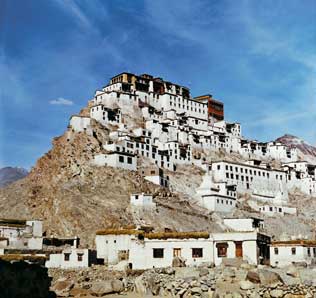 | |
| The Central-Asian expedition caravan 1925 – 1928. |
The Central-Asian expedition became the main accomplishment in the life of N. Roerich. All his life before the expedition was preparation for it, all his future life was working on its results.
The expedition caravan, having started from India in the 20-s of the XX century, passed through China, Siberia, Altai, Mongolia, Tibet, and came back to India again. On the relief map in the center of the hall, a chain of red lights shows the way passed by the expedition over highest mountains, vast deserts, and boundless steppes of Asia.
“No museum, the painter put down in one of his expedition diaries, no book will give the right to portray Asia or any other countries, if you have not seen them with your own eyes, if you did not at least take memorial notes in the actual place. Persuasiveness, this magic quality of creative work, inexplicable with words, is only created by way of stratifying true impressions of the reality”1.
The “true impressions of the reality” lie at the basis of all Roerich’s creative work – literary essays, diary notes, wonderful paintings, in which subtle scientific information is presented with an artist’s inspired hand.
 | |
| Tikse monastery. Ladakh. Photograph by L. Shaposhnikova |
In the hall of the Central-Asian expedition, you can see Nicholas Roerich’s paintings; photographs telling about the events en route; a collection of antiquities and relics of the East; objects which passed whole Asia with the travelers; books dedicated to the expedition.
The “true impressions of the reality” are also revived on the colorful photographs exhibited in the hall. These shots were taken by L. Shaposhnikova, the N. Roerich Museum Director. Scientist-Indologist, Academician of the Russian Academy of Natural Sciences and the Tsiolkovsky Russian Academy of Cosmonautics, scholar of N. Roerich’s creative and scientific heritage, Ludmila Shaposhnikova went along Roerich’s Central-Asian expedition itinerary at the end of the 1970-s. Big bright photos visually illustrate Nicholas Roerich’s diary records.
The artist got seriously interested in the East, and especially India, when he was still young. He was convinced that in high antiquity there was a common source which formed the Slavic and Indian cultures. To “follow a new direction to the sources of Indian art and life”2 starting from the Russian life – this prospect carried away and excited him. A travel to the East was becoming inevitable.
In 1918, Nicholas Roerich with Helena Roerich and their sons went from Finland to Scandinavian countries, and then to England, America, France. This was a period of preparation for the main voyage of his life. Close contacts with Orientalists of America and Europe, with many Indian workers of art and science were established. Paintings exhibitions-sales, cultural initiatives in America, foundation of the Nicholas Roerich New York Museum, provided material possibilities for the expedition organization.
…On December 2, 1923, steamer “Macedonia” entered the harbor of Bombay. Among the passengers coming down from the ladder, was N. Roerich with his family.
For a month, the Roerichs traveled through the Indian planes. Neither foreign domination, nor the advance of modern civilization could kill the refined beauty of the ancient Indian culture. “You see the old powerful culture in the acquired harmony of the song, in the character of the call, in the movements, – the artist wrote down in is diary. – And there was neither Rome nor Greece, when India was flourishing”3. India became the initial and final point of the Central-Asian expedition.
At the end of 1923, they arrived in Darjeeling – a small city in the foothills of the Eastern Himalayas. When, in search of a suitable house, they were climbing the slope of a mountain called “Birch Mountain”, the fog which was thickly covering the mountains started curling, and radiant peaks of Kanchenjunga showed up. For a moment, the time disappeared, and they remembered their youth, the house in Izvara, and the painting hanging in one of the rooms…
1N. Roerich. The Heart of Asia. – S-Pb., 1992. – p. 4.
2N. Roerich. About the Ancient Times of Praying. Pages. Fairy-Tales. – М.: ICR, 1999. – p. 240.